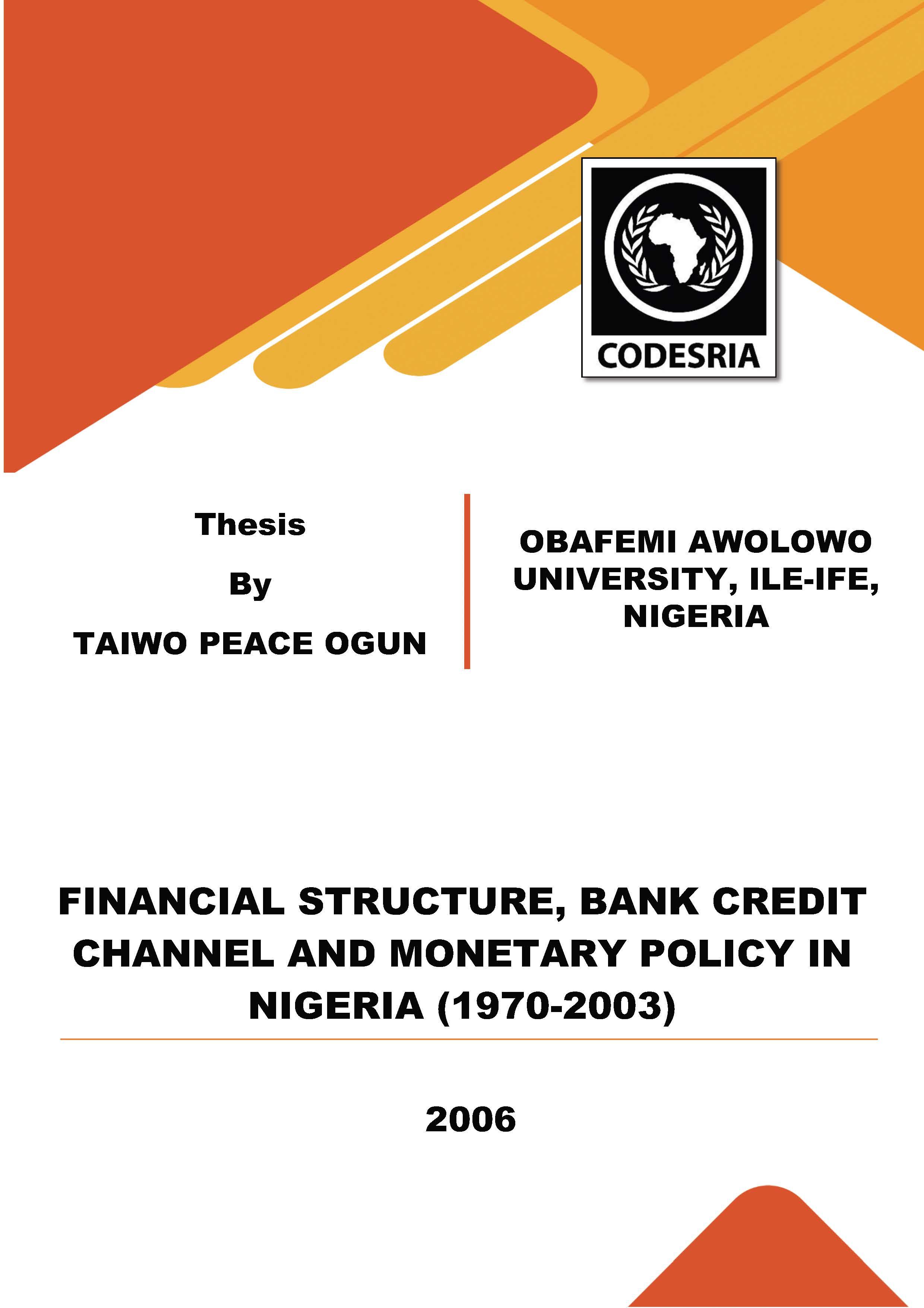FINANCIAL STRUCTURE, BANK CREDIT CHANNEL AND MONETARY POLICY IN NIGERIA (1970-2003)
Keywords:
STRUCTURE, BANK, CREDIT, MONETARY POLICY, NIGERIASynopsis
The study examined the impact of monetary policy on bank lending and investigated the importance of bank credit channel with the deregulation of the financial sector in Nigeria. It also considered the issue as to whether money or credit aggregate was the main cause of variability in economic activity and prices in Nigeria. This was with a view to providing empirical evidence on the implication of the structure of the financial markets on bank credit channel of monetary transmission in Nigeria.
Secondary data sourced from the Central Bank of Nigeria’s Statistical Bulletin and IMF’s International Financial Statistics for the period 1970-2003 were used for the analysis. Both descriptive statistics and econometric techniques were employed in the study. The Structural Vector Autoregressive (SVAR) econometric technique was applied in the analysis of the Bernanke and Blinder’s Commodity and Credit (CC) framework. In addition, other complementary techniques like the Impulse Response Functions (IRFs), Forecast Error Variance Decomposition (FEVD) and Granger Causality Test (GCT) were used as analytical tools.
The results showed that though the Nigerian financial sector was important in the light of its contribution to the macroeconomy, it was still underdeveloped relative to international standard. The results further showed that though Nigeria was a bankdominated economy, the structure of the financial system, had in recent times tended towards a capital market-based system. The SVAR econometric results indicated that, using nominal values of bank balance sheet variables, an unanticipated 1.71% hike in treasury bill rate led to a decline of only 0.9% and 1.2% in bank securities after the first and second quarter and increased afterwards. A negative response occurred in bank deposit and bank credit (total loans and advances) and the maximum impact of monetary policy on both variables was a decline of 2.2% which occurred after 13th and 19th quarter respectively. Real GDP and consumer prices also declined by 0.9% and 2.8% after the 1st and 5th quarter respectively, while nominal exchange rate depreciated immediately following monetary policy shock (measured as unanticipated hike in treasury bill rate) and appreciated after the 2nd quarter. Also, the average lending rate of banks increased immediately following the unanticipated 1.71% hike in treasury bill rate. The estimation of the SVAR using real values of bank balance sheet variables also indicated that these variables showed positive though declining innovations. The FEVD revealed that after 12 quarters bank credit contributed only 3% to the forecast error variance of the real GDP and 30% to the forecast error of consumer prices, while nominal exchange rate contributed 27% to the fluctuation in output. Monetary policy shock also accounted for only 1% and 7% of the forecast error variance of bank loans and advances after the 4th and 12th quarter respectively. The GCT also indicated that while bank deposits was the main source of variability in prices, nominal exchange rate was the basic cause of fluctuation in real activity in Nigeria.
The study concluded that the bank credit channel was weak in the Nigerian economy. The major source of variability in economic activity was the nominal exchange rate while the main cause of fluctuation in prices was bank deposits.
Downloads
References
Butzen, P., F. Catherine and Vermeulen, P.(2001): “The Interest Rate and Credit Channels in Belgium: An Investigation With Micro-Level Firm Data”, European Central Bank, Monetary Transmission Network Frankfurt, Germany.
Calomiris, C., and G. Hubbard (1986): "Imperfect Information, Multiple Loan Markets, and Credit Rationing", Northwestern University, mimeo.
Campbell, R.H.,(2004): “The FreeDictionary.Com www.thefreedictionary.com/ Financial +structure
Carcia, C.J. and Restrepo, J.E. (2001), “Price Inflation and Exchange rate Pass-through in Chile”, Working Paper of Central Bank of Chile, No. 128.
Carrasquilla, A., (1998): “Monetary Policy Transmission: the Colombian Case”, Bank of International Settlement Policy Papers, No. 3, pp. 81-104.
Ceccheti, S.G.,(1995): “Distinguishing Theories of the Monetary Transmission Mechanism,” Federal Reserve Bank of St. Louis Economic Review Vol. 77, (May/June), pp. 83-97.
Ceccheti, S.G.,( (1999): “Legal Structure, Financial Structure, and the Monetary Policy Transmission Mechanism,” Federal Reserve Bank of New York Economic Policy Review (July), pp. 9-28.
Cecchetti, S.G. and S. Krause (2001): “Financial Structure, Macroeconomic Stability and Monetary Policy”, Working Paper 8354, National Bureau of Economic Research, Massachusetts Avenue, Cambridge (July).
Central Bank of Nigeria (1993): CBN Brief – Research Department, Series No. 93/103.
Central Bank of Nigeria (2000a): The Changing Structure of the Nigerian Economy.
Central Bank of Nigeria, Abuja.
Central Bank of Nigeria (2000b): CBN Briefs, Research Department. (June).
Central Bank of Nigeria(2003): Statistical Bulletin, (December) Vol. 14
Chirinko, R.S. (1993): “Business Fixed Investment Spending: A Critical Survey,” Journal of Economic Literature Vol. 31, (December), pp. 1875-1911.
Christiano, L.J., M. Eichenbaum and C. Evans (1996): “The Effects of Monetary Policy Shocks: Evidence from the Flow of Funds,” Review of Economics and Statistics Vol. 78, No. 1, pp. 16-34.
Christiano, L.J., M. Eichenbaum and C. Evans (1999): “Monetary Policy Shocks: What Have We Learned and to What End?” Handbook of Macroeconomics, Vol. 1A, Elsevier Science B.V.
Citu, F.V.,(2003): “A VAR Investigation of the Transmission Mechanism in New Zealand,” Federal Reserve Bank of New Zealand. www.ifk-cfs.de/papers/Citu.pdf






